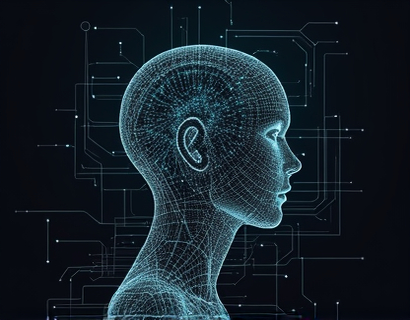Harnessing Crypto and AI: Transforming User Engagement in the Digital Ecosystem
The digital ecosystem is undergoing a profound transformation, driven by the convergence of cryptocurrency and artificial intelligence (AI). This synergy is not just a technological advancement but a paradigm shift that is redefining how users engage with digital platforms and services. By leveraging the unique properties of blockchain technology and the computational prowess of AI, businesses and innovators can create more immersive, secure, and personalized experiences. This article delves into the intricate relationship between crypto and AI, exploring how these technologies can be harnessed to enhance user engagement and drive growth in the digital landscape.
Understanding the Basics: Cryptocurrency and AI
To fully appreciate the transformative potential of crypto and AI, it's essential to understand the fundamentals of each technology. Cryptocurrency, often referred to as digital or virtual currency, operates on a decentralized network known as a blockchain. This technology ensures transparency, security, and immutability, making it an ideal foundation for various applications beyond mere transactions. On the other hand, AI refers to the simulation of human intelligence processes by machines, particularly computer systems. These processes include learning (the acquisition of information and rules for using it), reasoning (using rules to reach approximate or definite conclusions), and self-correction.
When combined, cryptocurrency and AI create a powerful toolset for developers and businesses. The decentralized nature of crypto provides a trustless environment where AI can operate without the need for central authorities, reducing friction and enhancing efficiency. Conversely, AI can optimize the use of cryptocurrency, from enhancing security protocols to improving user experience through personalized interactions.
The Synergy of Crypto and AI in User Engagement
The integration of crypto and AI in user engagement strategies offers several compelling advantages. One of the most significant benefits is the enhancement of security. Blockchain technology ensures that user data and transactions are secure and tamper-proof. AI can further bolster this security by detecting and mitigating potential threats in real-time, using machine learning algorithms to identify patterns and anomalies. This dual-layer security approach not only protects user information but also builds trust, a critical factor in user engagement.
Personalization is another area where crypto and AI intersect to transform user experiences. AI algorithms can analyze vast amounts of user data to understand preferences, behaviors, and needs. This insights-driven approach allows for highly personalized content and recommendations, keeping users engaged and satisfied. In a crypto-enabled ecosystem, these personalized experiences can be monetized through tokenized rewards, where users earn tokens for participating in specific activities or achieving certain milestones. These tokens can then be used within the platform or exchanged, creating a seamless and incentivized engagement loop.
Tokenization and Incentivization
Tokenization, a process where assets are represented by digital tokens on a blockchain, plays a crucial role in enhancing user engagement. By tokenizing rewards, loyalty programs, and in-platform currencies, businesses can create more dynamic and interactive user experiences. For instance, a digital content platform can issue tokens that users earn by creating, sharing, or engaging with content. These tokens can be used to access premium content, vote on platform decisions, or even traded for fiat currency or other cryptocurrencies. This not only increases user participation but also fosters a sense of community and ownership.
AI can optimize the tokenization process by predicting user behavior and tailoring token rewards to maximize engagement. Machine learning models can analyze user interactions to identify the most effective reward structures, ensuring that users are motivated to continue engaging with the platform. Additionally, AI can automate the distribution of tokens, ensuring fairness and transparency, which are key to maintaining user trust and satisfaction.
Decentralized Applications and User Empowerment
Decentralized applications (dApps) are a prime example of how crypto and AI can revolutionize user engagement. dApps operate on blockchain networks, leveraging smart contracts to automate and secure interactions. These applications can offer users greater control over their data and digital identities, as well as more transparent and equitable reward systems. AI enhances dApps by providing intelligent interfaces and personalized user experiences. For example, an AI-driven dApp can adapt its user interface based on the user's preferences and behavior, making the application more intuitive and user-friendly.
Moreover, dApps can leverage AI to offer predictive analytics and insights, helping users make informed decisions. In a financial dApp, for instance, AI can analyze market trends and provide personalized investment recommendations, all while ensuring that the underlying transactions are secure and transparent. This combination of decentralization and intelligence not only empowers users but also opens up new opportunities for innovation and growth.
Building Trust Through Transparency
Trust is a fundamental component of user engagement, and the combination of crypto and AI can significantly enhance transparency. Blockchain's immutable ledger provides a clear and verifiable record of all transactions and interactions, reducing the risk of fraud and manipulation. AI can further enhance transparency by providing real-time insights and explanations of complex processes. For example, AI-driven dashboards can visualize blockchain transactions, making it easier for users to understand and trust the system.
Transparency also extends to the development and deployment of AI models. By using open-source AI frameworks and allowing users to audit algorithms, businesses can build trust and demonstrate their commitment to ethical AI practices. This level of transparency not only attracts users but also fosters a community of trust and collaboration.
Challenges and Considerations
While the potential benefits of integrating crypto and AI are substantial, there are also challenges and considerations that must be addressed. One of the primary concerns is regulatory compliance. The crypto space is still largely unregulated, and the use of AI adds another layer of complexity. Businesses must navigate varying legal frameworks and ensure that their applications comply with data protection laws, anti-money laundering regulations, and other relevant regulations.
Another challenge is the technical expertise required to develop and maintain crypto and AI systems. These technologies are complex and require a skilled workforce. Businesses need to invest in training and hiring professionals who can effectively integrate and optimize these technologies. Additionally, the computational resources required for AI, especially for tasks like training machine learning models, can be significant. Efficient resource management and scalable infrastructure are essential to support these operations.
Strategies for Successful Integration
To successfully harness the power of crypto and AI, businesses should adopt a strategic approach. First, it's crucial to conduct thorough research and understand the specific needs and pain points of the target audience. This insight will guide the development of crypto and AI solutions that truly add value. Collaboration with tech experts and early adopters can provide valuable feedback and accelerate the innovation process.
Building a robust and secure infrastructure is another key factor. This includes implementing state-of-the-art blockchain solutions and ensuring that AI systems are scalable and efficient. Security should be a top priority, with continuous monitoring and updating of protocols to address emerging threats. User education is also important, as many users may be unfamiliar with crypto and AI concepts. Providing clear and accessible information can help demystify these technologies and encourage adoption.
Finally, fostering a community around the platform can drive engagement and loyalty. Engaging with users through forums, social media, and other channels can help gather feedback, build trust, and create a sense of belonging. By creating a supportive and inclusive community, businesses can ensure that their crypto and AI initiatives are well-received and widely adopted.
Conclusion
The integration of cryptocurrency and artificial intelligence represents a significant leap forward in the digital ecosystem. By leveraging the security, transparency, and personalization capabilities of these technologies, businesses can create more engaging, secure, and rewarding user experiences. While challenges exist, the potential benefits are immense, offering a pathway to sustained growth and innovation. As the tech landscape continues to evolve, those who embrace the synergy of crypto and AI will be well-positioned to lead the way.










































